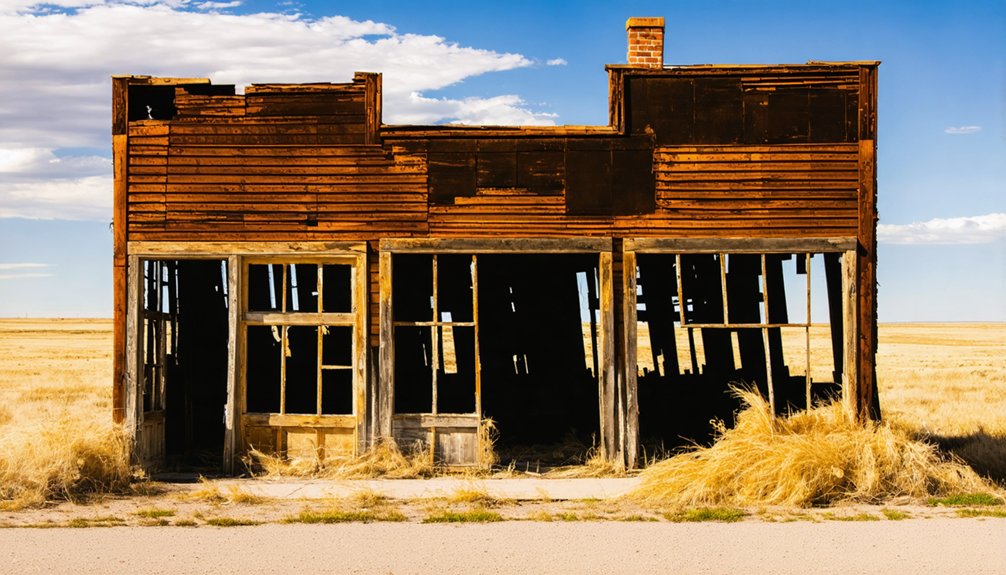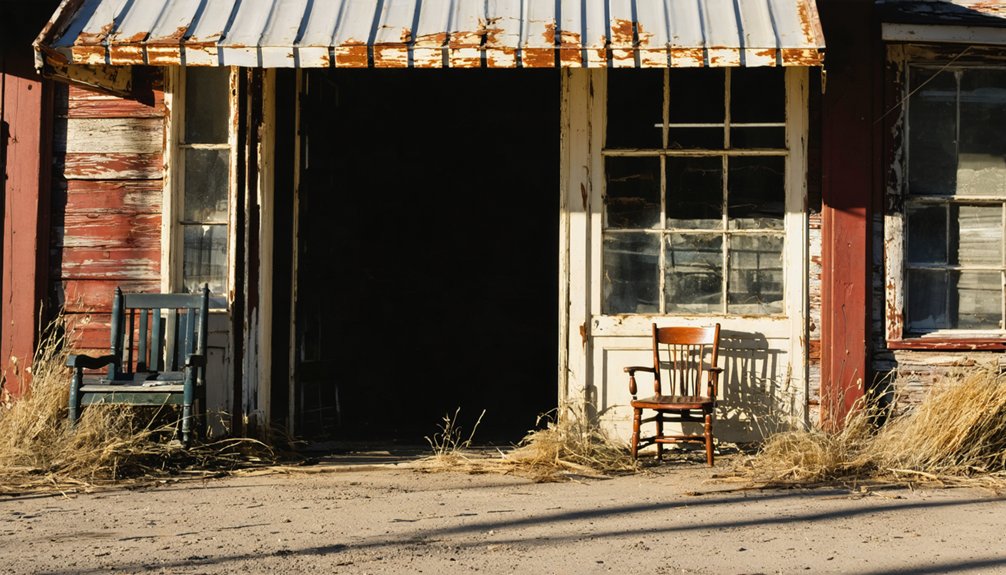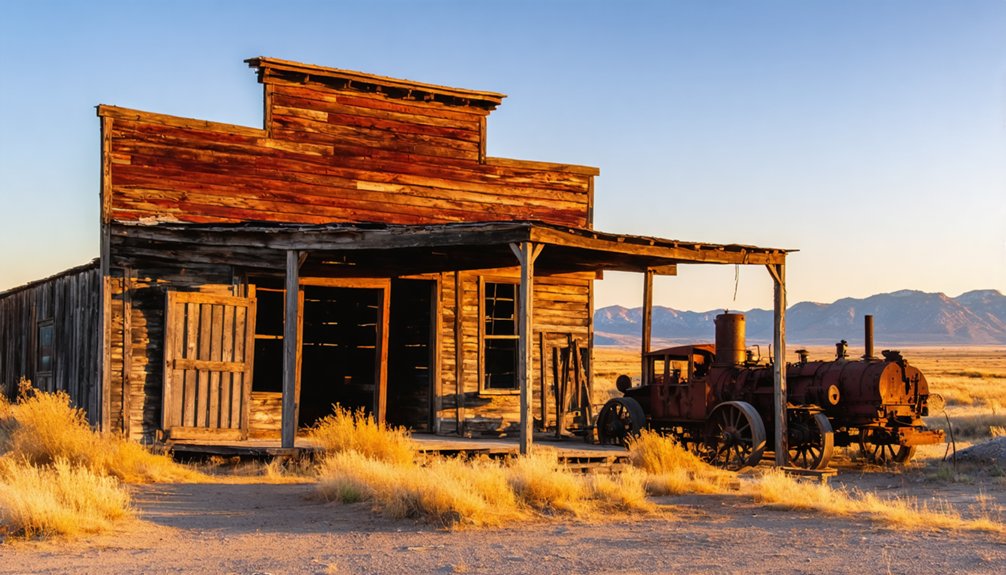You’ll find Canyon City nestled in Spearfish Canyon, where the 1874 Custer Expedition sparked a gold rush that birthed this once-thriving Black Hills settlement. Founded in 1876, it flourished with mining operations, including the Empire Zinc Smelter that employed 400 workers between 1902-1968. The town’s Victorian architecture and mining remnants tell a tale of boom-and-bust, from gold discoveries to its eventual abandonment – a story etched in South Dakota’s rugged landscape.
Key Takeaways
- Canyon City was established in 1876 during the Black Hills gold rush following discoveries made during Custer’s 1874 expedition.
- The town thrived initially through gold mining operations, with the Empire Zinc Smelter employing 400 workers from 1902-1968.
- Mining methods evolved from placer mining to advanced hard-rock extraction, utilizing 20-stamp mills and Blake Crushers.
- The town’s decline began in the early 1900s due to diminishing ore quality and increasing extraction costs.
- The Great Depression accelerated Canyon City’s abandonment, leading to closure of schools, shops, and essential services.
The Rise of a Black Hills Mining Settlement
When gold was discovered in the Black Hills during the Custer Expedition of 1874, it sparked one of America’s last great gold rushes.
You’ll find that Canyon City, like many Black Hills settlements, emerged during the fevered staking of mining claims in 1876, when prospectors flooded into the territory seeking their fortunes.
The Gorman brothers from Canada were among the first to establish mining operations in the region, setting up two productive mines.
As you explore the history of this ghost town, you’ll discover how early settlers were drawn by the promise of both placer gold in the streams and the harder-to-reach lode deposits in the surrounding hills.
The settlement quickly grew as miners established their claims and businesses sprang up to support them. The treasure coaches transporting gold from the region became frequent targets for highway robbers.
Fortune seekers transformed raw wilderness into bustling camps as businesses arose to serve the growing mining community.
While the nearby Homestake Mine drew much attention, Canyon City’s prosperity hinged on the development of new extraction methods for the area’s challenging refractory ore deposits.
Life During the Gold Rush Years
Despite the allure of striking it rich, daily life in Canyon City during the gold rush years proved incredibly challenging for its inhabitants. You’d have found yourself living in hastily built log cabins or tents, battling muddy streets and constant health threats from poor sanitation. Your daily routines would’ve revolved around grueling 12-hour shifts in dangerous mines or supporting industries like timbering and railroad construction.
While life was harsh, community events helped forge bonds among residents. You could’ve found entertainment at the local saloons, dance halls, or theatrical performances. Women ran boarding houses and shops, while men toiled underground. The influx of miners violated the Treaty of Fort Laramie, creating ongoing tensions with local tribes. Wild Bill Hickok was famously killed during a poker game, highlighting the dangerous nature of frontier life.
Disease outbreaks, claim disputes, and harsh winters tested everyone’s resolve. Yet the town persevered, gradually establishing schools, churches, and formal law enforcement as families put down roots.
Mining Operations and Economic Impact
You’ll find Canyon City’s gold mining reached its peak in the mid-1870s when operations shifted from early placer mining to more sophisticated lode mining methods, exemplified by the Hidden Treasure Mine with its patented claims and quartz crushing mill.
The introduction of advanced equipment like Blake Crushers and 20-stamp mills revolutionized ore processing capabilities, though complex operational challenges and equipment limitations affected long-term productivity. Similar to other mining operations like the Badger Mill, the equipment upgrades allowed for increased ore processing capacity through multiple stamp configurations.
Mining activity drove the local economy through cycles of boom and bust, with successful operations attracting hundreds of residents and spurring the growth of supporting businesses including general stores, hotels, and transportation infrastructure.
Gold Mining Peak Years
As fortune seekers flooded into the Black Hills between 1876 and 1877, Canyon City witnessed an unprecedented gold mining boom that transformed the region’s economic landscape.
You’d have seen wildcat miners staking claims along every creek and gulch, desperately searching for their share of Black Hills gold. Within those peak years, the region’s mining technology rapidly evolved from simple placer mining to sophisticated quartz crushing operations. Early miners used chlorination and smelting techniques to process challenging refractory gold ore by 1890.
The discovery of the Homestake Mine near Lead in 1876 sparked a dramatic shift in the gold rush era.
You’ll find it fascinating that this single mine would eventually produce 10% of the world’s gold supply over 125 years. Individual prospectors soon gave way to organized mining companies, forever changing the way gold was extracted from the Black Hills.
Resource Extraction Methods
Mining operations in Canyon City evolved through distinct technological phases, beginning with simple placer mining along streambeds before advancing to more sophisticated hard-rock extraction methods.
You’d find early prospectors sifting through creek sediments, collecting loose gold particles that had eroded from nearby deposits.
As surface gold became scarce, miners shifted to hard-rock mining, digging deep underground to follow gold-bearing veins.
They’d process the ore through 40-ton stamp mills, like the one at Maitland, crushing the rock to release precious metals.
Mercury amalgamation proved essential for processing free-milling ores, while more complex chemical treatments tackled stubborn refractory ores.
The mining economy diversified beyond gold, expanding into copper, tungsten, and silver extraction, though environmental challenges from acid mine drainage would later require extensive remediation efforts.
The ore’s high value of $30 per ton made mining operations particularly lucrative for companies in the region.
The area’s mining legacy includes the famous Homestake mine, which dominated gold production in the region for over 125 years.
Economic Boom and Bust
When gold was discovered in the Black Hills in 1874, Canyon City experienced an explosive economic transformation that would define its destiny for generations. The mining community flourished as placer gold attracted thousands of prospectors seeking quick fortunes.
You’d have witnessed an economic resurgence as the town rapidly developed with general stores, hotels, and eventually a railroad connection in 1906. The Empire Zinc Smelter provided jobs for up to 400 workers during its operation from 1902 to 1968.
The town’s prosperity hinged on mining success, with operations extracting gold, silver, and coal. A single coal mine employed 90 men and produced 300 tons daily before its 1907 closure. Like many ghost town hunting sites today, careful research and exploration are required to locate the remnants of these once-thriving operations.
But like many boom towns, Canyon City’s fortunes followed the mines. When claims failed or large operations shut down, businesses closed and people left, eventually leading to the town’s decline and transformation into the ghost town you’ll find today.
Architecture and Infrastructure

As you explore Canyon City’s architectural remains, you’ll find the Chicago, Milwaukee & St. Paul Railroad’s influence reflected in its utilitarian wooden depots and warehouses that once served as essential transportation hubs.
Victorian design elements grace the brick commercial buildings and manager residences, showcasing the brief period of prosperity through ornate window frames and decorative cornices.
The town’s infrastructure reveals a mix of practical construction methods, from simple wooden worker housing near the rail yards to more substantial stone and brick structures in the business district.
Building Materials and Methods
The architectural legacy of Canyon City reveals a diverse array of building materials and construction methods that suited both the region’s mining operations and its aspirations for permanence.
You’ll find local stone masonry showcasing late Victorian Gothic influences in the town’s banks and public buildings, while timber-framed structures dominated the mining landscape. Workers used abundant local timber to quickly construct miners’ cabins, shaft houses, and boarding houses.
The town’s industrial structures combined durability with practicality.
You’ll notice corrugated metal and reinforced concrete in the processing facilities, particularly where cyanide vats required chemical resistance. Modular, prefabricated components allowed for rapid assembly of temporary mining structures, while more permanent buildings featured brick and stone construction, demonstrating Canyon City’s evolution from a mining camp to an established settlement.
Victorian Design Elements
Victorian grandeur dominates Canyon City’s architectural landscape through elaborate design elements that transformed simple mining structures into sophisticated statements of prosperity.
You’ll find ornate “gingerbread” trim adorning eaves and porches, while patterned brickwork and stone detailing enhance the facades’ textural richness. The town’s Victorian ornamentation extends to its steeply pitched roofs with multiple gables, creating dynamic silhouettes against the canyon backdrop.
As you explore the streets, you’ll notice tall, narrow windows with rounded arches and decorative bay windows that break up flat wall planes.
The architectural symmetry of the era reveals itself in the presidential neighborhood’s stately homes, where transom-crowned doorways and iron-crested rooflines showcase the period’s attention to detail.
Original brick-paved streets and cast-iron lampposts complete this preserved Victorian streetscape.
Transportation Hub Remnants
Deep within Spearfish Canyon, remnants of an ambitious railroad project still mark the landscape, telling stories of early twentieth-century engineering triumphs.
As you explore, you’ll discover the transportation evolution from rail to modern highways, with weathered foundations and gravel beds marking the canyon’s rail legacy.
The hub’s most notable features included:
- Grain elevators and warehouses strategically placed along sidings
- Maintenance yards with rusting ironwork remains
- Water tank foundations for steam locomotives
- Historic depot platforms where communities once gathered
You can still trace the original rail route through surviving infrastructure elements, from crumbling stone mounds to abandoned grade crossings.
These silent sentinels stand as evidence to the region’s pioneering spirit, even as Interstate 90 carved new pathways through the Black Hills.
The Path to Abandonment

Four major factors drove Canyon City’s abandonment, beginning with the steep decline of its mining industry in the early 1900s.
You’ll find that diminishing ore quality and rising extraction costs made operations like the Penobscot and Beltram mines increasingly unprofitable, crushing the town’s economic backbone.
Despite the community’s resilience, the lack of railroad access proved fatal, as neighboring towns with better transportation links drew away both business and residents.
The Great Depression delivered another blow, accelerating the exodus of miners and their families.
Historical preservation efforts couldn’t save Canyon City’s essential services – schools, shops, and social institutions shut down as the population dwindled.
Preserving Canyon City’s Legacy Today
Through coordinated preservation efforts, Canyon City’s legacy endures as part of the Black Hills’ rich mining heritage.
You’ll find the town’s story preserved through community involvement and documentary projects, while nearby historical societies work to protect these valuable remnants of the past.
When visiting Canyon City today, you’ll discover several key preservation efforts in action:
- Historical society partnerships documenting oral histories and photographs
- Educational tours connecting tourists to authentic mining heritage sites
- Community-led storytelling initiatives preserving local narratives
- Documentary films highlighting the town’s cultural significance
Like its neighbor Deadwood, Canyon City benefits from regional preservation frameworks that protect historic structures from destruction.
These efforts guarantee you can experience this authentic piece of Black Hills history while supporting sustainable tourism that keeps its legacy alive for future generations.
Frequently Asked Questions
Are There Any Reported Ghost Sightings or Paranormal Activity in Canyon City?
You won’t find documented ghostly encounters or spectral sightings specific to this location, though surrounding Black Hills ghost towns commonly report paranormal activity tied to their mining history and abandoned structures.
What Wildlife Species Now Inhabit the Abandoned Buildings of Canyon City?
You’ll find a thriving wildlife adaptation with bats roosting in rafters, owls in church towers, rodents scurrying through walls, and various snakes, lizards, and insects making these building inhabitants their home.
Was There Ever a Major Crime Wave or Notorious Outlaw in Canyon City?
Despite a million frontier tales, you won’t find any major crime waves or outlaw legends in this town’s history. Historical records show Canyon City remained relatively peaceful during its mining heyday.
Did Any Famous Historical Figures Visit or Stay in Canyon City?
You won’t find documented evidence of famous visitors to this mining settlement. While Alexander Maitland had historical significance running the nearby Penobscot Mine, most traffic consisted of miners and engineers.
What Native American Tribes Lived in the Canyon City Area Before Mining?
Picture ancient camps along Rapid Creek, where you’d find the Arikara first, followed by Cheyenne, Crow, and Kiowa tribes, until the Lakota’s powerful culture dominated the sacred Black Hills region.
References
- https://www.sdpb.org/rural-life-and-history/2023-08-21/some-black-hills-ghost-towns-and-their-origins
- https://www.sdhspress.com/journal/south-dakota-history-2-2/some-black-hills-ghost-towns-and-their-origins/vol-02-no-2-some-black-hills-ghost-towns-and-their-origins.pdf
- https://www.youtube.com/watch?v=_0WNYsFLSLA
- https://www.blackhillsbadlands.com/blog/post/old-west-legends-mines-ghost-towns-route-reimagined/
- https://myxoadventures.com/the-ghost-town-of-spokane-south-dakota/
- https://www.geotab.com/ghost-towns/
- https://en.wikipedia.org/wiki/List_of_ghost_towns_in_South_Dakota
- https://ruralresurrection.com/ghost-towns-mystic-south-dakota/
- https://www.blackhillshikingbikingandmore.com/old-mining-ghost-towns
- https://en.wikipedia.org/wiki/Black_Hills_gold_rush



